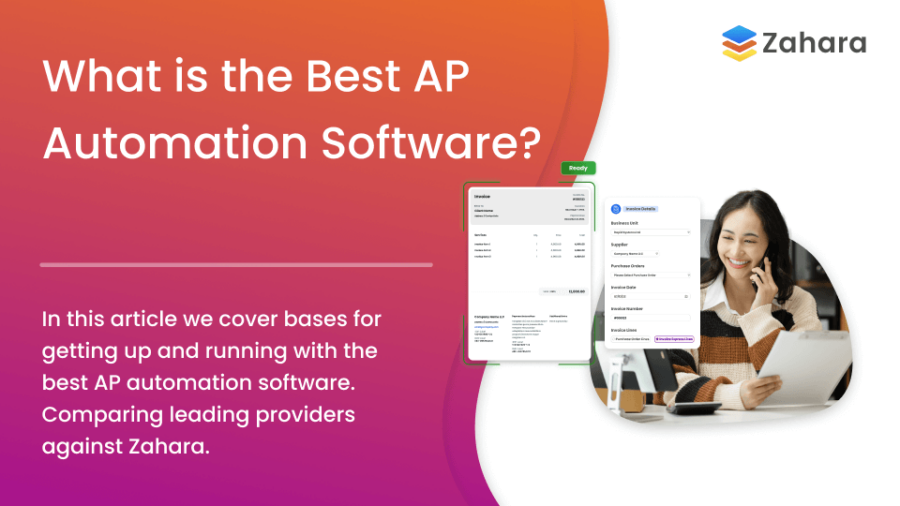If you’re searching for the best accounts payable automation software to elevate your finance operations, you’re in the right place. The world of AP automation is growing rapidly, offering a wealth of options that can streamline your processes—but making the right choice can feel overwhelming. This guide highlights the non-negotiable features you need, explains how automation works, reviews pricing insights, and explains why our solution, Zahara, could be the ideal fit for your business.
Table of Contents
Why Automate Your Accounts Payable?
To put it simply, you’d like the best accounts payable software possible. Automating your accounts payable process isn’t just about reducing manual data entry. It’s about achieving the following:
- Greater Control: Tighten your expense management and gain visibility over your spending.
- Enhanced Efficiency: Automate repetitive tasks to reduce errors and save time.
- Improved Accuracy: Leverage advanced tools like Optical Character Recognition (OCR) to process invoices down to each line item.
- Streamlined Payments: Simplify your payment processes with integrated solutions that maintain full audit trails.
Comparing Accounts Payable Automation Tools?
If you’re evaluating AP automation alternatives or want to replace your manual accounts payable process, it’s important to choose software that aligns with your goals. Whether you’re comparing top AP automation tools or reviewing accounts payable software options, Zahara gives you a complete solution for purchase orders, invoice approvals, and payments—all in one platform. This guide helps you compare AP software features, pricing, and benefits to make the right choice for your business.
| Provider | Key Features | Best For | Website |
|---|---|---|---|
| Zahara | Multi-step approvals, invoice automation, PO matching | SMEs & Mid-market finance teams | Visit Zahara |
| Yooz | Fast invoice capture, cloud-based archive, mobile access | Medium-sized businesses | Visit Yooz |
| Bill.com | Integrations with Xero, QuickBooks, flexible payment scheduling | Small businesses & freelancers | Visit Bill.com |
| Tipalti | Global payments, tax compliance, ERP integrations | Scaling tech companies & global finance teams | Visit Tipalti |
| Stampli | AI-powered invoice capture, Slack integration, vendor chat | Collaborative AP teams | Visit Stampli |
| Airbase | Corporate cards, expense control, full spend management | Startups & VC-backed companies | Visit Airbase |
Looks like you’ve covered a lot of info. We’re here to answer any questions you might have.
Zahara is the Best Accounts Payable Software for the Price
For growing teams looking to get ahead of the curve Zahara is available from £118 per month (annually). For high-performance companies who need more visibility and spend-control Zahara is from £219 per month (annually), learn more about Zahara’s features: here. Look at our pricing page to learn more about bolt-ons: here.
At Zahara, we’ve built our AP automation software solution around the four critical elements of an effective accounts payable process:
Purchase Orders
A robust purchase order system is your first line of defence against overspending. Zahara lets you set strict budgets and implement multi-step approval workflows, ensuring that spending aligns with your company’s financial policies before committing any money.
Invoice Processing
Manual invoice processing can be a major bottleneck. Zahara automates this task using OCR technology, allowing you to process invoices up to nine times faster while reducing human error. This means your team can focus on strategic tasks rather than tedious data entry.
Approvals
Clear, customizable approval workflows are essential for maintaining control over your expenditures. With Zahara, you can tailor approval paths to suit any scenario—from routine office supplies to significant capital investments—providing both security and flexibility.
Payments
Completing the process, Zahara integrates with trusted payment providers to facilitate seamless payment runs. This integration simplifies your workflow by grouping invoices and maintaining a complete audit trail, ensuring that every transaction is documented and compliant.
Your Roadmap for the Best Accounts Payable Automation Software
Choosing and implementing new software might seem like a daunting task, but breaking it down into clear steps can make the transition smoother:
Step 1: Assess Your Current Process
Begin by analyzing your existing accounts payable workflow. Identify the areas where manual processing is holding you back, pinpoint your pain points, and note what features are essential for your new system.
Step 2: Identify Your Must-Have Features
The best accounts payable software should include:
- OCR for Invoice Scanning: Automates the capture of invoice data.
- Approval Workflows: Ensures that every purchase is vetted and within budget.
- Seamless Integration: Works in harmony with your existing accounting systems, such as Sage, Xero, or QuickBooks.
Step 3: Schedule Live Demonstrations
Seeing the software in action is invaluable. During a demo, ask detailed questions about how the system handles your specific needs. A knowledgeable expert will walk you through each feature, explain pricing transparently, and help you understand the system’s real-world benefits.
Step 4: Prepare for Implementation
Once you’ve chosen a solution, get your team and data ready for the transition. Work with the provider to clean up your records and create a comprehensive implementation plan that includes realistic timelines and team responsibilities.
Step 5: Implement the Software
Collaboration is key during the rollout. Work with your provider to migrate your data, configure the system to your requirements, and integrate with your current ERP or accounting system. Comprehensive training for your team is essential to ensure a smooth transition.
Step 6: Optimize and Refine Your Process
After implementation, continuous improvement is vital. Regular reviews of your AP process will help you refine workflows and ensure you’re fully leveraging the benefits of automation. A responsive provider will assist you with adjustments as your business grows and your needs evolve.
Zahara helps to complete all key aspects of the AP process.
Download Our Guide to AP AutomationHow Much Does the Best AP Automation Cost?
Pricing for accounts payable automation software depends on the package’s functionality and the scale of your operations. Typically:
- Small to Mid-Sized Businesses: Expect to start from around £120 per month for a comprehensive 4-in-1 solution.
- Larger Enterprises: More advanced needs might range from £500-£700+ per month.
At Zahara, our full-service package is available for £119 per month—or as low as £99 per month when paid annually—delivering a complete solution without the need to piece together multiple apps.
Learn more on our pricing page.
Zahara vs Manual Accounts Payable
See the difference automation makes — from invoice to payment.
| Manual AP Process | Zahara | |
|---|---|---|
| Invoice Capture | Email, printing, scanning | Automated capture via email, drag-and-drop, or OCR |
| Approval Routing | Manual forwarding via email or paper | Multi-step approval workflows by department, site, or role |
| Duplicate Detection | Manual cross-checking (high risk) | Built-in duplicate invoice detection |
| Month-End Close | Slow, error-prone, and fragmented | Faster, centralised reporting and approvals |
| Visibility & Control | Limited, especially across teams or sites | Real-time AP dashboard with audit trails |
| Cost & Efficiency | High admin costs, delays, and errors | Lower processing costs and faster decisions |
Why Choose Zahara for Your Accounts Payable Automation?
Our users consistently praise Zahara for its intuitive design and powerful capabilities. Here’s what some of our customers have to say:
“Zahara is intuitive and easy to use. It has helped us gain control of our purchasing, deliver our projects on budget, improve cash flow, and build stronger relationships with our suppliers and sub-contractors.” – Purchasing Manager, Citu
“Zahara makes it easy to raise an order and has powerful approvals that our business needs. The budgets feature is fantastic.” – Sharon Turner, Group Financial Controller, 4D Pharma
“Zahara has been a complete revolution for our clients.” – Bridge Financials
Implementing the best accounts payable software is a strategic investment in the future of your business. With Zahara, you not only streamline your AP processes but also empower your finance team to focus on growth and strategic initiatives.
Read more of our customer success stories here: Customer Success
What’s Next for Your Accounts Payable?
Transitioning to an automated accounts payable solution can fundamentally transform your finance operations. Instead of settling for manual processes or fragmented systems, choose a solution designed specifically to meet the unique challenges of your business.
If you’re part of an SME or a growing enterprise looking for a complete solution—including purchase orders, invoice processing, approvals, and integrated payments—reach out to our team today. We’re here to support you every step of the way.
For more insights on AP automation and its benefits, explore additional resources on reputable platforms such as G2.
By following this guide, you’re well on your way to implementing the best accounts payable automation software that meets your business’s unique needs. Happy automating!


